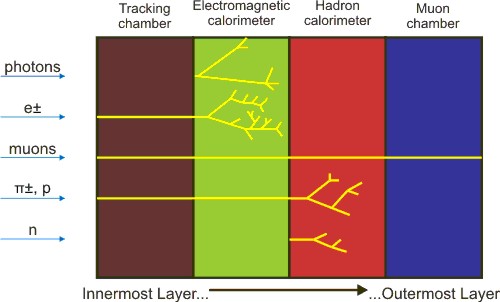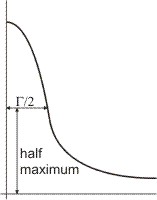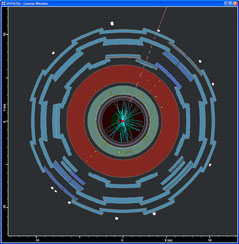
|
Throughout the project you will be looking at different "events" which
happen when there is a proton-proton collision. The first item which
you will observe in every event, there are the traces which the particles
leave in the different parts of the detector and lines called "tracks"
which join the traces belonging to the same particle. The detector
surrounds the region where the collisions take: in the following picture,
it is represented as the red inner circle. Originating from the centre,
there are short tracks and long tracks. The short tacks can belong to
any kind of charged particles but the long ones belong to muons which
are the only charged particles which can reach the outer parts of the detector.
The following shows a example of how different particles interact with different
parts of a detector. Note that the neutral particles leave traces only in the
calorimeters (so you should see no tracks in the inner black circle) but only in
the green and red. On the other hand the neutrinos are "invisible" they do not
leave any traces! They only way to "guess" their presence is from the missing
energy/momentum which is discussed at the end of this page.

|

|
For reasons, which are connected with the uncertainty principle, if the particle
is very short lived, then the measurement of its energy and therefore its invariant
mass has an uncertainty. It does not always have the same value but its histogram
(distribution of values) is peaked around the nominal mass value but follows a certain
distribution as shown in the figure. The width at half-maximum is labeled as Γ and is connected
to the particle's lifetime. The width of the particle gives very valuable information
and has to be measured. As an example we quote that the measurement of the width of
the Z particle in LEP (CERN's previous big accelerator which was replaced by LHC)
gave a very good determination of the number of different neutrinos types which exist.
|

|
This is the momentum/energy which is not detected in the detector, but is expected
because of energy and momentum conservation. The Emiss is generally attributed to
particles which escape the detector without being detected such as the neutrinos
(although apparent missing energy may be caused by mismeasurement of the momentum/energy
of detected particles). In LHC, the initial momentum of the colliding constituents
along the beam axis is not known (because the energy of each hadron is split, and
constantly exchanged, between its constituents), so the amount of missing energy
cannot be determined. However, the initial energy and momentum transverse to the
beam axis is zero, so any net momentum indicates missing transverse momentum/energy (Etmiss).
It is represented (in the event display) with a dashed line which in addition to the
value (which is the magnitude of the transverse missing momentum/energy) shows the
direction of the missing transverse momentum.
|





